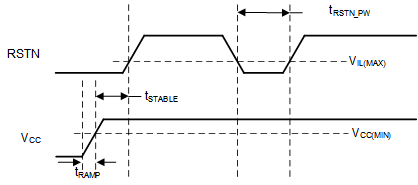| POWER UP TIMING |
| TRSTN_PW |
Minimum width to detect a valid RSTN signal assert when the pin is actively driven low |
100 |
|
|
µs |
| TSTABLE |
VCC must be stable before RSTN de-assertion |
300 |
|
|
µs |
| TREADY |
Maximum time needed for the device to be ready after RSTN is de-asserted. |
|
|
500 |
µs |
| TRAMP |
VCC ramp time |
0.2 |
|
100 |
ms |
| I2C (STD) |
| tSUSTO |
Stop setup time, SCL (Tr=600ns-1000ns), SDA (Tf=6.5ns-106.5ns), 100kHz STD |
4 |
|
|
µs |
| tHDSTA |
Start hold time, SCL (Tr=600ns-1000ns), SDA (Tf=6.5ns-106.5ns), 100kHz STD |
4 |
|
|
µs |
| tSUSTA |
Start setup time, SCL (Tr=600ns-1000ns), SDA (Tf=6.5ns-106.5ns), 100kHz STD |
4.7 |
|
|
µs |
| tSUDAT |
Data input or False start/stop, setup time, SCL (Tr=600ns-1000ns), SDA (Tf=6.5ns-106.5ns), 100kHz STD |
250 |
|
|
ns |
| tHDDAT |
Data input or False start/stop, hold time, SCL (Tr=600ns-1000ns), SDA (Tf=6.5ns-106.5ns), 100kHz STD |
5 |
|
|
µs |
| tBUF |
Bus free time between START and STOP conditions |
4.7 |
|
|
µs |
| tLOW |
Low period of the I2C clock |
4.7 |
|
|
µs |
| tHIGH |
High period of the I2C clock |
4 |
|
|
µs |
| tF |
Fall time of both SDA and SCL signals |
|
|
300 |
ns |
| tR |
Rise time of both SDA and SCL signals |
|
|
1000 |
ns |
 Figure 1. Power On and Reset Timing
Figure 1. Power On and Reset Timing  Figure 2. I2C Timing
Figure 2. I2C Timing